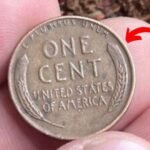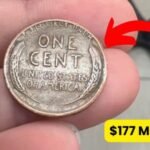Imagine reaching into your pocket for spare change and pulling out a penny worth nearly a million dollars. Sounds like a fantasy, right? But the Lincoln Wheat Penny, specifically a rare variant valued at $947,000, is no myth. This humble one-cent coin, minted between 1909 and 1958, could still be hiding in circulation—maybe in your coin jar, wallet, or even a dusty piggy bank. Let’s dive into the fascinating story of this coin, why it’s so valuable, and how you might spot one.
What Is the Lincoln Wheat Penny?
The Lincoln Wheat Penny, also called the “Wheat Cent,” was introduced in 1909 to honor Abraham Lincoln’s 100th birthday. Designed by Victor David Brenner, it was the first U.S. coin to feature a real person’s face—Lincoln’s iconic profile. The reverse side showcases two wheat stalks, giving the coin its nickname. Minted until 1958, billions of these pennies flooded American pockets, but a few rare versions are now worth a fortune.
Why does this coin matter? Beyond its historical significance, certain Wheat Pennies, due to minting errors or low production, have become collector’s gold. One such coin, rumored to be valued at $947,000, is sparking excitement among numismatists and everyday folks alike.
The $947,000 Penny: What Makes It So Special?
So, what’s the deal with this $947,000 Lincoln Wheat Penny? The jaw-dropping value likely ties to a rare minting error, such as the 1943 Bronze Cent. During World War II, copper was critical for war efforts, so the U.S. Mint switched to zinc-coated steel for pennies in 1943. However, a handful of copper planchets (blank coins) from 1942 were accidentally struck with the 1943 design. Fewer than 20 of these “1943 Bronze Pennies” are known to exist, making them incredibly rare.
In 2010, a 1943-D Bronze Lincoln Wheat Penny sold for $1.7 million at auction, but experts estimate a pristine example could fetch $947,000 or more today, depending on condition. Other valuable variants, like the 1955 Doubled Die or 1909-S VDB, also command high prices due to low mintage or errors. The rarity, historical context, and condition drive these coins’ value sky-high.
Could This Penny Still Be in Circulation?
Here’s the exciting part: some of these rare pennies might still be out there. Because they look similar to regular pennies, many went unnoticed for decades. Stories of lucky finds fuel the hype. For example, in 1980, a teenager in Massachusetts found a 1943 copper penny in his pocket change, later valued at over $40,000. More recently, collectors have reported finding valuable Wheat Pennies in old coin rolls or inherited collections.
According to numismatic expert Jeff Garrett, “It’s not impossible to find a rare Wheat Penny in circulation. People often overlook old coins, and families cash in jars of change without checking.” While the odds are slim, the possibility keeps treasure hunters scouring their spare change.
How to Spot a Valuable Lincoln Wheat Penny
Want to know if you’re holding a $947,000 penny? Here’s a quick guide to spotting a valuable Lincoln Wheat Penny:
Check the Date and Mint Mark
Look at the year on the coin. Key dates include:
- 1909-S VDB: Only 484,000 minted, with the designer’s initials on the reverse.
- 1914-D: Low mintage, highly sought after.
- 1943 Bronze: Copper-colored, not steel.
- 1955 Doubled Die: Noticeable doubling on “Liberty” and the date.
Check for a mint mark under the date: “S” for San Francisco, “D” for Denver, or no mark for Philadelphia. Rare mint marks boost value.
Test the Material
For 1943 pennies, use a magnet. Steel pennies stick; copper ones don’t. A 1943 copper penny weighs about 3.11 grams, heavier than the 2.7-gram steel version.
Look for Errors
Examine the coin for doubling (like the 1955 Doubled Die) or off-center strikes. These errors make coins unique and valuable.
Assess Condition
Coins in mint or uncirculated condition fetch the highest prices. Avoid cleaning your penny—oils or scratches can slash its value.
If you suspect you’ve found a rare coin, consult a professional grading service like PCGS or NGC for authentication.
Why Are Collectors Obsessed with Wheat Pennies?
Lincoln Wheat Pennies aren’t just coins; they’re time capsules. Minted during pivotal moments like the Great Depression and World War II, they carry stories of American resilience. Collectors value their rarity, but also their connection to history. “Each penny tells a story,” says coin dealer Laura Sperber. “Finding a rare one is like uncovering a piece of the past.”
The numismatic market is booming, with rare coins often outperforming stocks. In 2023, Heritage Auctions reported a 15% increase in rare coin sales, driven by demand for Wheat Pennies and other classics. This trend makes the $947,000 penny a tantalizing prospect for collectors and investors.
What to Do If You Find a Rare Penny
Found a suspicious penny? Don’t spend it! Follow these steps:
- Handle with Care: Hold the coin by its edges to avoid damage.
- Store Safely: Place it in a protective holder to prevent wear.
- Get It Appraised: Visit a reputable coin dealer or grading service.
- Sell Smart: Auction houses like Heritage or eBay (with professional grading) can maximize value.
One cautionary tale: in 2019, a seller cleaned a 1909-S VDB penny, reducing its value from $50,000 to under $1,000. Always seek expert advice before acting.
The Thrill of the Hunt
The Lincoln Wheat Penny valued at $947,000 is more than a coin—it’s a dream. The idea that a life-changing treasure could be hiding in your change jar is thrilling. Whether you’re a seasoned collector or just curious, checking your pennies is a fun, low-risk adventure. Who knows? That dusty old coin might be your ticket to a windfall.
So, next time you get change at the store, take a closer look. A quick glance could reveal a piece of history worth nearly a million dollars. Happy hunting!



